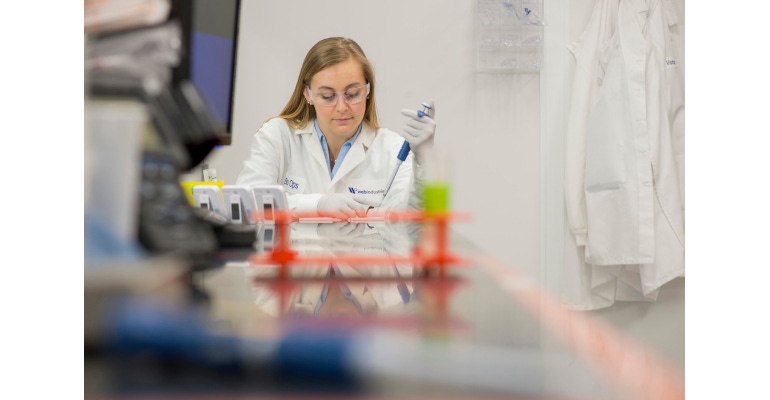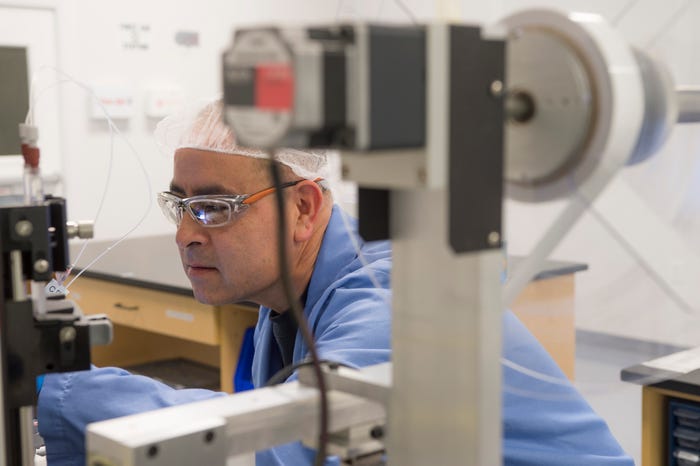The COVID-19 pandemic has prompted medical device manufacturers to re-evaluate their supply chains. Here’s a look at why some are considering onshore, outsourced manufacturing of rapid diagnostic tests.

Lateral flow immunoassay (LFI) rapid diagnostic tests play an essential role in the fight against COVID-19’s spread, but before the pandemic erupted, many LFI devices were imported into the United States from lower-cost-manufacturing countries. As was the case with numerous medical products, LFI device global supply chains experienced interruptions when COVID-19 slowed or stopped incoming shipments from China and other nations.
Now, medical device original equipment manufacturers (OEM) are evaluating their supply chains with a renewed emphasis on stability. They want to avoid future disruptions. One of the big questions on the table: What role will U.S. manufacturing play in the new normal? The answer is particularly important for critical medical devices, therapeutics, and supplies such as ventilators, pharmaceuticals, personal protective equipment (PPE), and diagnostic tests. After all, these products are necessary to combat the very virus that turned up the spotlight on supply-chain resiliency.
Onshoring: What It Is and Why It Matters
“Onshoring,” like the word “outsourcing,” can mean different things to different organizations, depending on the context. Sometimes “onshoring” is used interchangeably with “reshoring” and “nearshoring.” At times, it is used to mean the opposite of outsourcing or offshoring. Here is how medical device industry consultant Mark Bonifacio summed it up in a recent presentation about reshoring:
“Offshoring is the relocation of a business process from one country to another—typically an operational process, such as manufacturing, or supporting processes, such as accounting. … Offshoring and outsourcing are not mutually inclusive: There can be one without the other. They can be intertwined (offshore outsourcing), and can be individually or jointly, partially or completely reversed, involving terms such as reshoring, inshoring, and insourcing.” 1
For purposes of this article, onshoring refers to manufacturing in the United States, whether that be in-house OEM production or outsourced production by contract manufacturing organizations (CMO). Onshoring is one tactic within broader nearshoring initiatives. Also referred to as regionalization, nearshoring brings supply chains closer to a device’s commercial market. For example, nearshoring of medical devices destined for the U.S. market could include moving manufacturing to the United States or other nearby countries.
Onshoring has bipartisan political support and growing favor with the U.S. business community and public. From politicians to business leaders to the average American, there is a desire to see the United States be able to procure mission-critical medical devices and supplies in times of crisis. With painful lessons of COVID-19 shortages still fresh, businesses and government are rethinking how supply chains should perform in the future. They are putting greater focus on biodefense, crisis preparedness, stability, and predictability.
In addition, onshoring drives employment, and there is strong support for business strategies that will create U.S. jobs, enhance workforce development, and strengthen the economy.
Onshoring of LFI Rapid Diagnostic Tests
Onshoring is a critical consideration for COVID-19 rapid test manufacturers. Like their counterparts developing other crucial tests, devices, and vaccines, these businesses are at the heart of efforts to control the virus, get the economy back on track, and enable Americans to safely go about their lives.
LFI antigen tests for COVID-19 can reveal results within 15-30 minutes. Because their sensitivity is not quite as strong as gold-standard molecular tests, antigen tests sometimes are referred to as “screening tests.” They can be quickly administered and read to determine with a high degree of accuracy whether a person is infected and should quarantine. They are easy to use at the point of care and less costly than most molecular tests, some of which require samples to be evaluated in specialized laboratories.
Experts agree that widespread testing is essential to control COVID-19’s spread and that rapid tests, in particular, play a vital role. “Without mass testing—which relies on the availability of high-performing, rapid tests—the disease will continue to spread,” the World Health Organization said. “Mass testing strategies depend on simple, high-performing rapid tests, preferably that can be administered right at the point of care or even at home.” 2
While testing trends and policies continue to evolve, there is some consensus that tens of millions of tests should be conducted across the U.S. population every week to reduce COVID-19 spread. The Rapid Acceleration of Diagnostics (RADx) initiative of the U.S. National Institutes of Health aims to expand test capacity by December 2020 to accommodate daily testing of 2 percent of the U.S. population. That adds up to 6 million tests per day, or 42 million tests weekly. 3 The Rockefeller Foundation puts the ideal U.S. testing level at 30 million tests per week, including 25 million screening tests and 5 million diagnostic tests across U.S. workplaces, schools, and other public settings. 4
“Testing is the only way out of our present disaster, and it will remain the case until a vaccine or effective therapeutics are widely available,” The Rockefeller Foundation said.
Onshoring Strategies
With such compelling reasons to contain COVID-19 and so much riding on rapid testing, there is a pragmatic need to ensure LFI rapid tests can be made available to U.S. businesses and the general public without supply threats, interruptions, or unpredictability. For OEMs, onshoring offers a solution to secure at least a certain percentage of their overall LFI device capacity. Outsourcing production to a CMO with domestic manufacturing operations is one onshoring path. With this approach, OEMs do not assume the financial risks and day-to-day challenges of starting up and running their own U.S. factories.
Still, establishing new supply chains can be a daunting proposition, even on familiar U.S. soil. Here are vital considerations to keep in mind and qualities to look for in a U.S. CMO partner:
Ability to execute a seamless transition. An OEM might be looking to transfer or duplicate capacity from captive or noncaptive (owned or contract) offshore manufacturing sites. Whatever the scenario, a CMO must help the OEM make that shift smoothly. Look for partners who can demonstrate how they have achieved similar transitions for other customers. Ask about their experience in setting up centers of excellence and manufacturing hubs in different parts of the United States and the world to provide responsive service.
Track record for technology transfer. Taking a device from the whiteboard to the factory floor requires proven protocols for process design and optimization. A CMO should provide a clear roadmap for how it will work with an OEM to perform engineering studies, raw material assessments, manufacturing process validation, and quality verification at key mile markers.
Multifaceted expertise. An onshore CMO must excel at not only efficient manufacturing but also supply chain and logistics management. While leading CMOs will offer a one-stop-shop in many ways, chances are they will need to source materials and components from both U.S. and international suppliers. Expect the CMO to manage supply-chain opportunities and risks. Also, CMOs must speak the same scientific language as OEM customers. They also should be able to run a robust gamut of material and chemical tests and experiments. Look for a CMO with in-house biochemistry expertise and strong laboratory resources.
Medical-grade quality systems. There are important certifications CMOs must have as the ticket to doing business in the world of diagnostic device production. Ask prospective CMO partners to provide documentation of: factory registration with the U.S. Food and Drug Administration (FDA), certification under the International Organization for Standardization (ISO) 13485 global standard for medical device quality management systems, demonstration of Current Good Manufacturing Practices (CGMP), and certification under ISO 9001 for standardized quality principles.
Automation. Onshoring does come with some higher costs, but a U.S. CMO can deliver LFI devices with optimal cost efficiency by leveraging automation. Automation also ensures the highest levels of quality assurance and product consistency by reducing risk for human error. Automated machinery and robotic systems are essential to successfully scale device production to the millions and billions of units required for the pandemic response.
Reputation. As with any hiring decision, the selection of a domestic CMO should include a thorough evaluation of a potential partner’s reputation. Look for a contractor that has staying power and stability. Ask for customer references. Expect transparency and responsiveness in all business dealings. These are the foundations of trust.

Above: Automation, such as reel-to-reel manufacturing equipment for LFI devices, enables U.S. CMOs to minimize labor costs, ensure consistent quality, and scale production.
The U.S. response to COVID-19 depends on rigorous population testing and a secure supply of critical medical devices, including rapid LFI antigen tests. Onshoring of LFI device production is one strategy OEMs can deploy for greater supply-chain resiliency and stability. With the right domestic CMO in their corner, they can outsource this domestic production with minimal risk and optimal predictability.
References
Bonifacio Consulting Services LLC. “Reshoring Manufacturing: What to Expect and Potential Challenges” Presentation. Medical Product Outsourcing Symposium. October 2020.
World Health Organization, Access to COVID-19 Tools Accelerator (ACT-Accelerator) Diagnostics Partnership, “Investing in Diagnostics to Manage the Course of the COVID-19 Pandemic” Investment Case, May 2020.
The New England Journal of Medicine. “Rapid Scaling Up of Covid-19 Diagnostic Testing in the United States — The NIH RADx Initiative” Special Report. July 2020.
The Rockefeller Foundation, National Covid-19 Testing & Tracing Action Plan Summary, July 2020.
About the Author(s)
You May Also Like


